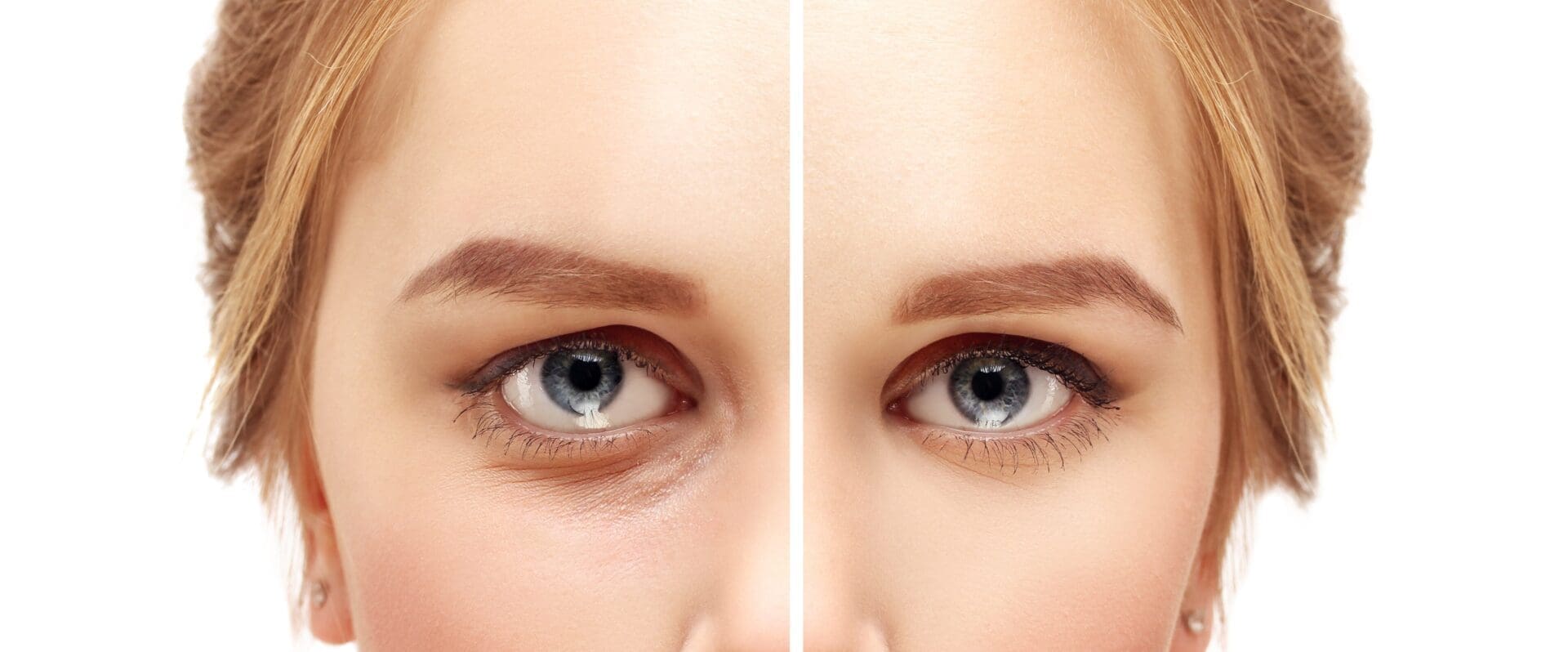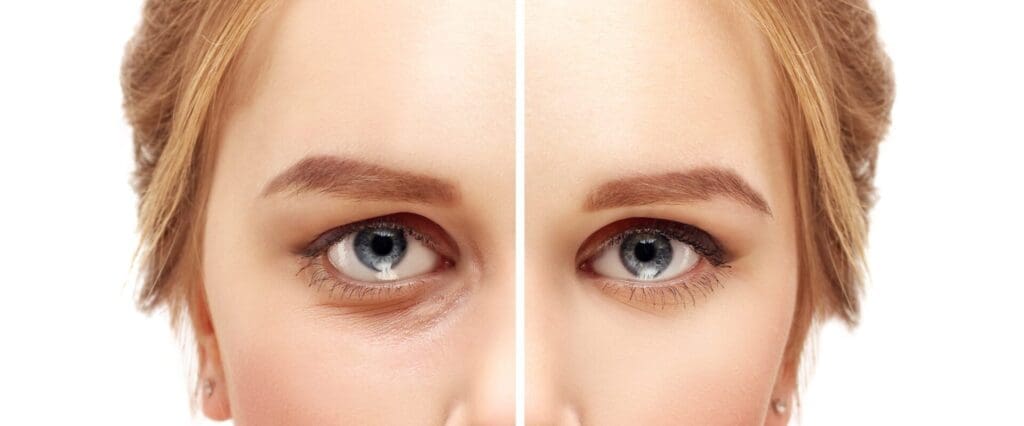
UPPER AND LOWER EYELID LIFT, OR BLEPHAROPLASTY
With aging comes the effects of gravity, loss of natural soft tissue elasticity, and fullness developing in areas where we would rather not experience it. The eyelids can sometimes harbor the first signs of aging in some people’s faces. Sagging or extra skin in the upper or lower eyelid can make you appear tired, angry, or frustrated even if you’re not. If severe, eyelid aging can even result in partial vision loss. The aging signs around the eye, except for the “crow’s feet” of the lateral eye, are also not treated by Botox, which is a common misconception. There are various non-surgical treatments for signs of aging of the upper and lower eyelid, including laser treatments for skin rejuvenation or filler treatments to camouflage the undereye “bags,” otherwise known as the “tear trough deformity.” But the highest yield of any eyelid rejuvenation procedure is going to be surgery with an eyelid lift, otherwise called a blepharoplasty.
What Does an Eyelid Lift Fix?
A blepharoplasty, or eyelid lift, is an outpatient surgical procedure that features the removal of excess skin and fat deposits, which are removed from the upper and/or lower eyelid. An upper eyelid lift involves an incision made on the upper eyelid, and the excess skin and fat are removed. The muscles around the eye are then tightened, and the remaining skin is lifted. In a lower eyelid lift, Dr. Day will make a small incision within the eyelid and under the lower lash line to remove fatty deposits and any excess skin tissue. The eyelids have very predictable fat pads that can begin to protrude when we age, causing increased prominence of the areas around the eyes. This can manifest as several aesthetic concerns one has regarding their eye area, such as:
- Sagging, puffy, or loose skin around the eyes
- Under-eye bags, or tear trough deformity, which forms a half circle under the eye in the lower eyelid
- Excess fat deposits
- Unwanted eyelid folds, coarse and fine lines
- Hooded eyelid that drapes down over the side portion of the upper eyelid
- Blockage of portions of the field of vision
How Does an Eyelid Lift Work?
In a blepharoplasty procedure, each portion of an eyelid’s signs of aging can be reversed through:
- The removal of excess skin
- Removal of portions of the fat pads
- Tightening of the internal structures that have become lax and sagging
Not only can an eyelid lift eliminate these cosmetic concerns, but it can help you obtain a more refreshed, youthful, and attractive appearance. In some cases, an eyelid lift even helps to improve one’s vision and create rounder-looking eyes. Candidates for eyelid surgery include anyone that is in reasonably good health and is unhappy with the skin around their eye. Additionally, eyelid surgery can sometimes help with a medical condition called ptosis.
There are additionally some special scenarios for eyelid procedures, such as Asian patients that want to transform their eyelid into a more almond-shape, the so-called “Asian blepharoplasty” or “double-lid surgery.”
Patients are typically amazed at how little scarring is experienced long-term after eyelid surgery. Depending on the severity of your eye bags and skin concerns, Dr. Day may be able to perform your eyelid surgery with no external incision. Additionally, many choose to combine an eyelid lift surgery with other non-invasive procedures, such as lasers and micro-needling, to maximize results.
Recovering From an Eyelid Lift?
Since eyelid surgery is an outpatient procedure, you’ll be able to return home immediately after. Patients typically experience swelling, bruising, and some mild discomfort immediately following the procedure up until a few days. Some also experience blurred vision, dry eyes, and a slight sensitivity to bright light. Keep in mind that these side effects are completely normal for this type of procedure and should disappear after a few days.
Dr. Day and his team will direct you to use a cold compress, pain medication, and prescription eyedrops to help you manage discomfort and minimize swelling in the days following your surgery. They will also provide a prescription ointment to apply to your surgical incisions. It is recommended that you take 3-5 days off work and avoid heavy lifting and exercise for up to two weeks following the surgery.
The lower eyelids can sometimes harbor signs of aging in the form of under eye bags, or “tear trough deformity.” This is a correctable condition, which is treated by the surgical removal of some very predictable fat pads along with elimination of excess skin. A very reliable approach in a paper by leading experts describes our approach to this condition. If you’ve been told that you look tired, unrested, have under-eye bags, or employ the famous cucumber slices and cool compresses frequently, then you may benefit from this uplifting procedure. It can have a powerful effect on the signs of facial aging in the middle face. Reach out today to see if you’re a candidate!
UPPER AND LOWER EYELID LIFT, OR BLEPHAROPLASTY
With aging comes the effects of gravity, loss of natural soft tissue elasticity, and fullness developing in areas where we would rather not experience it. The eyelids can sometimes harbor the first signs of aging in some people’s faces. Sagging or extra skin in the upper or lower eyelid can make you appear tired, angry, or frustrated even if you’re not. If severe, eyelid aging can even result in partial vision loss. The aging signs around the eye, except for the “crow’s feet” of the lateral eye, are also not treated by Botox, which is a common misconception. There are various non-surgical treatments for signs of aging of the upper and lower eyelid, including laser treatments for skin rejuvenation or filler treatments to camouflage the undereye “bags,” otherwise known as the “tear trough deformity.” But the highest yield of any eyelid rejuvenation procedure is going to be surgery with an eyelid lift, otherwise called a blepharoplasty.
What Does an Eyelid Lift Fix?
A blepharoplasty, or eyelid lift, is an outpatient surgical procedure that features the removal of excess skin and fat deposits, which are removed from the upper and/or lower eyelid. An upper eyelid lift involves an incision made on the upper eyelid, and the excess skin and fat are removed. The muscles around the eye are then tightened, and the remaining skin is lifted. In a lower eyelid lift, Dr. Day will make a small incision within the eyelid and under the lower lash line to remove fatty deposits and any excess skin tissue. The eyelids have very predictable fat pads that can begin to protrude when we age, causing increased prominence of the areas around the eyes. This can manifest as several aesthetic concerns one has regarding their eye area, such as:
- Sagging, puffy, or loose skin around the eyes
- Under-eye bags, or tear trough deformity, which forms a half circle under the eye in the lower eyelid
- Excess fat deposits
- Unwanted eyelid folds, coarse and fine lines
- Hooded eyelid that drapes down over the side portion of the upper eyelid
- Blockage of portions of the field of vision
How Does an Eyelid Lift Work?
In a blepharoplasty procedure, each portion of an eyelid’s signs of aging can be reversed through:
- The removal of excess skin
- Removal of portions of the fat pads
- Tightening of the internal structures that have become lax and sagging
Not only can an eyelid lift eliminate these cosmetic concerns, but it can help you obtain a more refreshed, youthful, and attractive appearance. In some cases, an eyelid lift even helps to improve one’s vision and create rounder-looking eyes. Candidates for eyelid surgery include anyone that is in reasonably good health and is unhappy with the skin around their eye. Additionally, eyelid surgery can sometimes help with a medical condition called ptosis.
There are additionally some special scenarios for eyelid procedures, such as Asian patients that want to transform their eyelid into a more almond-shape, the so-called “Asian blepharoplasty” or “double-lid surgery.”
Patients are typically amazed at how little scarring is experienced long-term after eyelid surgery. Depending on the severity of your eye bags and skin concerns, Dr. Day may be able to perform your eyelid surgery with no external incision. Additionally, many choose to combine an eyelid lift surgery with other non-invasive procedures, such as lasers and micro-needling, to maximize results.
Recovering From Eyelid Surgery?
Since eyelid surgery is an outpatient procedure, you’ll be able to return home immediately after. Patients typically experience swelling, bruising, and some mild discomfort immediately following the procedure up until a few days. Some also experience blurred vision, dry eyes, and a slight sensitivity to bright light. Keep in mind that these side effects are completely normal for this type of procedure and should disappear after a few days.
Dr. Day and his team will direct you to use a cold compress, pain medication, and prescription eyedrops to help you manage discomfort and minimize swelling in the days following your surgery. They will also provide a prescription ointment to apply to your surgical incisions. It is recommended that you take 3-5 days off work and avoid heavy lifting and exercise for up to two weeks following the surgery.
The lower eyelids can sometimes harbor signs of aging in the form of under eye bags, or “tear trough deformity.” This is a correctable condition, which is treated by the surgical removal of some very predictable fat pads along with elimination of excess skin. A very reliable approach in a paper by leading experts describes our approach to this condition. If you’ve been told that you look tired, unrested, have under-eye bags, or employ the famous cucumber slices and cool compresses frequently, then you may benefit from this uplifting procedure. It can have a powerful effect on the signs of facial aging in the middle face. Reach out today to see if you’re a candidate!




